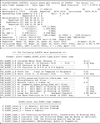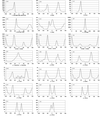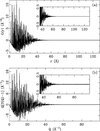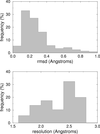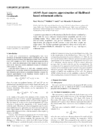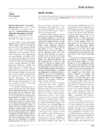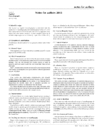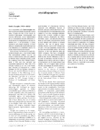issue contents
February 2003 issue

Cover illustration: Protein crystals in a 2 µl gelled microbatch drop dispensed automatically under oil. Courtesy of A. Moreno, E. Saridakis & N. E. Chayen [J. Appl. Cryst. (2002), 35, 140-142].
research papers
The onset of aggregation and the sol–gel transition in concentrated destabilized polystyrene sphere suspensions is investigated using a combination of time-resolved small-angle neutron scattering and diffusing wave spectroscopy.
Free 

This paper describes the concepts of validation and the classes of checks that are carried out by the program PLATON as part of the IUCr checkCIF facility. PLATON validation can be run at any stage of the structure refinement, independent of the structure determination package used, and is recommended for use as a routine tool during or at least at the completion of every structure determination.
The stress orientation distribution function (SODF) was recently introduced as a mean-field representation to describe the grain-orientation dependence of intergranular stress. A method is developed for constructing the SODF from strain pole figures measured with a pulsed neutron source and demonstrated with cold-rolled interstitial-free steel.
A new method for determining the hexagonal direction indices is introduced, which is more practical than other commonly used methods. The relationship between the crystallographic directions and the hexagonal direction indices for face-centred cubic crystals is derived.
The design and implementation of a new five-circle κ diffractometer for a reference-beam oscillation camera setup are presented.
Dihedral angles from 46 ultra-high-resolution protein structures have been examined to derive dihedral-angle restraints for protein structure refinement. Many of the dihedral-angle propensities and distributions found are at variance with current dihedral-angle restraints as implemented in the programs X-PLOR and CNS, and improved values are suggested.
High-Tc YBCO superconducting thin films have been studied by energy-dispersive X-ray diffraction. Rocking curves of all the accessible diffraction peaks were measured simultaneously, preventing the problems of reproducibility of the experimental conditions during an angular scan.
The phase diagram of K2MoxW1−xO4, both on heating and cooling, is presented. The observed nearly linear character of the concentration dependence of the modulation parameter p at 693 K (both after heating and cooling) indicates the existence of a continuous series of incommensurate structures in the concentration interval 0 ≤ x ≤ 1.
A practical scheme is given for optimizing total-scattering structure functions, S(Q), for direct Fourier transform.
InteGriTy, a software package to compute topological properties of electron densities given on three-dimensional grids, is presented.
The paper deals with a challenging topic of physical pharmacy, possibly concerning other emerging research fields: the determination of the weight fraction of a crystalline phase in largely amorphous composites. A quantitative X-ray diffraction (QXRD) analysis method, based on the assessment of the classic diffraction–absorption approach, is presented and discussed.
A multi-purpose heating attachment designed primarily for X-ray four-circle diffractometers but applicable also for classical powder diffraction is presented. When working in reflection geometry, the air-cooled heating stage allows diffraction studies to be performed on plate-like samples up to 1173 K in the whole orientation space.
A fast method for indexing powder diffraction patterns has been developed for large and small lattices of all symmetries. Comparison with three of the most popular indexing programs has shown that the present method is more successful at indexing simulated data.
This paper reports on the epitaxial growth of thin films of the ferroelectric Aurivillius phase SrBi2Nb2O9 on (110)SrTiO3 single-crystal substrates and discusses the film orientation and the film–substrate interface formation. In addition, a possible misinterpretation of the growth direction, due to a specific artifact, is highlighted.
An unexpected metastable Mn nitride phase (θ′), formed throughout the ferritic matrix of an Fe–Mn (1.62 wt% Mn) alloy during a nitriding treatment at 843 K for 8 h, adopts the form of plates. Its crystal structure is established by electron microdiffraction in conjunction with group-theory analysis.
Spin-echo small-angle neutron scattering (SESANS) is a new kind of SANS technique enabling measurements to be made directly in real space from a range of a few nanometres up to micrometres. In this paper it is shown that SESANS measures correlations directly.
Real-space interpretation of spin-echo small-angle neutron scattering (SESANS) is presented. The SESANS correlation function is calculated analytically for Gaussian coils, and solid and hollow spheres.
The relationship between the crystallographic resolution and the root-mean-square distance of protein structure pairs is presented. This is important to help avoid missing a similarity that could otherwise be hidden by differing accuracies of two protein structures.
A new computational approach to the Takagi–Taupin equations for the analysis of X-ray optics is presented and applied to heat-loaded synchrotron monochromators. The new numerical approach is based on the assumption that the incoming wave is completely incoherent (incoherent point source).
The orientation relationship of the transformation from f.c.c. to b.c.c. structure, measured with high-energy synchrotron radiation in an iron meteorite, consists of a continuous range of coplanar variants extending from the Nishiyama–Wassermann to the Kurdjumov–Sachs relationship, as well as a narrow transition path between non-coplanar variants.
The coordination complex [Ni(en)3]2+(NO )2 (en = 1,2-diaminoethane) undergoes a sharp reversible displacive phase transition at ∼109 K, changing space group from P6322 above the transition temperature to P6522 below. The phase change is accompanied by a tripling of the c axis on cooling, resulting in an easy detection of the transition in images from area-detector diffractometers.
)2 (en = 1,2-diaminoethane) undergoes a sharp reversible displacive phase transition at ∼109 K, changing space group from P6322 above the transition temperature to P6522 below. The phase change is accompanied by a tripling of the c axis on cooling, resulting in an easy detection of the transition in images from area-detector diffractometers.
A new modelling of mixed-layer minerals containing electrically charged layers is presented along with the mathematical formalism for the diffracted intensities of such a model.
short communications
The diffraction of X-rays by a thin layer (of the order of a few nanometres) with a gradient in interplanar spacings is considered. It is shown that optical coherence over the film thickness leads to diffraction peak positions that no longer obey Bragg's law.
computer programs
A computer program that calculates the parameters of the quadratic approximation of the maximum-likelihood criterion is proposed. The obtained parameters can be used in conventional least-squares refinement programs in order to improve the refinement procedure.
The computer program ANIZC calculates the diffraction contrast factors of dislocations in anisotropic cubic, hexagonal and trigonal crystals.
laboratory notes
Some preliminary tests at the crystallography beamline I711 at the MAX II synchrotron in Lund, Sweden, have shown that it is possible to use acoustical levitation to keep a droplet of liquid and solid (powder) samples in an X-ray beam for a sufficient time for collection of the X-ray diffraction pattern.
The use of a capillary-enclosed loop to simplify room-temperature data collection is described.
computer program abstracts
Interactive Web-based software, Water Analysis Package (WAP), has been developed to calculate the distances between water oxygen atoms and protein atoms. The package incorporates all the three-dimensional crystal structures available in the Protein Data Bank (the atomic coordinates being updated regularly from the RCSB-PDB server), as well as offering the option to upload the atomic coordinates (PDB format) of new structures from the client system.
book reviews
Free 

books received
Free 

international union of crystallography
Free 

crystallographers
Free 



 journal menu
journal menu










